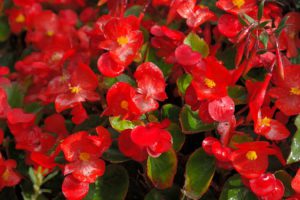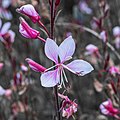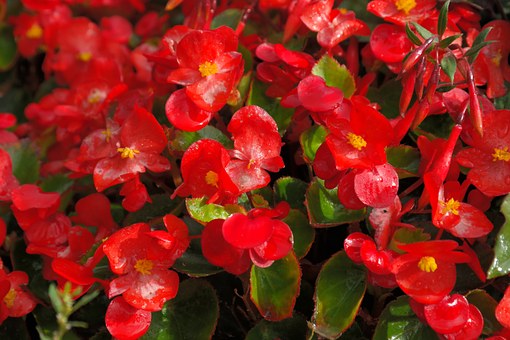In a previous article in the series, trees or shrubs that can be grown in containers was discussed. It is now our attention turns to perennials that can be grown in containers in the shade. As with the shrubs and trees, there are some crossover, as some perennials can be grown in both sun and shade. Most perennials will take some light shade, but most cannot take dense shading at all.

The plants that can be grown in the shade are more limited to those that can be grown in full sun, but there are plants of interest that will cover different leaf shapes and flower colours.
What follows are perennials that can be grown in containers in full shade. There will be a plant that will tickle your fancy.
BEGONIA ‘Olympia Series’

This is an evergreen perennial that is often used as an annual summer bedding plant. This 25cm tall plant has glossy, green leaves and small, white, pink or red flowers with golden centres. Can be planted in pots or hanging baskets of multipurpose compost.
BELLIS PERENNIS (Bell Daisy)

This familiar evergreen perennial has rosettes of spoon-shaped dark green leaves. The flowers are either single or pompon in nature, which are either pink, white or red in colour. The plants can be planted in pots, hanging baskets, or window boxes in multipurpose compost. It grows up to 20cm in height.
CAREX (Japanese Sedge) ‘Ice Dance’

As grasses and sedges do well in the shade, it comes as no surprise that these evergreens are much favoured in shady container gardens. This evergreen perennial sedge, have mounds of grassy, green leaves with creamy, white margins.
They produce small white flowers in spring, where it can be planted in pots in soil-based compost. It will grow up to 60cm in height, which will also prevent it from spreading, as it can be invasive in the ground.
CAREX OSHIMENSIS (Ornamental Sedge)

This small evergreen sedge that grows up to 20cm in height, has glossy, arching, dark green leaves with cream stripes in them. The flower spikes produced in summer are insignificant. They can be used in window boxes or pots, where in winter they will add extra interest.
CAREX SIDEROSTICHA (Broad-leaves Sedge)

This sedge is deciduous or semi-evergreen depending on where it is grown. In milder climates, it will be semi-evergreen whilst in cooler climates, it will be deciduous. This small perennial grows up to 30cm in height where arching, grassy, green leaves are produced. They are small brown flowering spikes found in spring. Variegate varieties have cream edges to its foliage. Plant in hanging baskets or pots full of soil-based compost.
DICHONDRA ARGENTEA (Silver Ponyfoot) ‘Silver Falls’

Silver falls is often sold as a summer bedding plant. It has cascading, silvery stems of round, shiny, silvery, green leaves. This leafy plant looks good as part of a mixed display, where it will grow up to 50cm in length. It can be grown in pots or hanging baskets full of multipurpose compost. Be wary as it will only tolerant light shade, so do not plant in areas of dense shade.
GAURA LINDHEIMERI (Wand Flower)

This upright perennial grows up to 1.5m in height, with its small lance-shaped, green leaves. The tall slim stems that are produced have dainty butterfly-shaped, pink-hued white flowers that appear all summer. Grow these perennials in a pot of soil-based compost in a sheltered spot.
HEUCHERA ‘Plum Pudding’

This tall Heuchera is evergreen in nature, where it is grown for its rounded, lobed and veined, maroon-purple leaves. Slim stems of small white flowers appear in summer. You can grow it as a foil for colourful flowers in window boxes or pots filled with soil-based compost. It will grow up to 50cm in height.
HEUCHERELLA ‘Tapestry’

This evergreen or semi-evergreen perennial has deeply lobed, green leaves with purple veins in them. Small sprays of pink flower appear in early summer. Plant in window boxes or pots in a sheltered spot full of soil-based compost, where it will grow to 30cm in height. Deadheading is required to prolong blooming.
IPOMOEA BATATAS (Sweet Potato Vine) ‘Blackie’

This perennial can be grown in full sun or in the shade. It is a trailing perennial that will grow up to 25cm in height. It is often used as an annual, where it produces lobed ivy-shaped, almost black leaves. Blackie looks stunning when grown in a hanging basket or tall container full of multipurpose compost.
LAMIUM MACULATUM (White Nana)

This small mat-forming semi-evergreen perennial can grow up to 15cm in height. It has white-variegated, mid-green leaves. The flower spikes of hooded, white flowers appear from late spring to the end of summer. It prefers to be grown in soil-based compost.
IMPATIENS ‘New Guinea Group’ (Busy Lizzie)

This short stubby perennial that grows up to 35cm in height, is often grown as an annual. It has glossy lance-shaped, green leaves, with vibrant pink, red, lavender or white flowers. The flowers appear throughout summer. It can be grown in hanging baskets, pots or window boxes full of multipurpose compost. Other varieties that can be considered is Impatiens wallerina.
NICOTIANA SYLVESTRIS (Flowering Tobacco)

This 15cm tall perennial has long, sticky, mid-green leaves. It is often grown as an annual. Heads of long tubular, white flowers appear in summer. The fragrant flowers can be enjoyed if this perennial is grown in a large container of multipurpose compost.
OPHIOPOGON PLANISCAPUS (Black Mondo Grass) ‘Nigrescens’

This foliage evergreen is a clump-forming perennial that has leathery grass-like leaves that are black in colour. In summer white or mauve bell-shaped flowers are produced, from which black berry fruits soon follow. This 23cm tall plant appreciates being grown in soil-based compost.
PETUNIA (Surfinia Series)

This trailing petunia grows up to 40cm in height, where dark green leaves are covered with a profusion of trumpet-shaped flowers. The flowers appear in summer and are in the shades of pink, purple, red, white or yellow. It prefers to be grown in multipurpose compost, where it can be planted in window boxes, hanging baskets or pots.
PRIMULA ‘Crescendo Series’ (Polyanthus)

This familiar perennial grows up to 20cm in height. It has rosettes of corrugated, dark, green leaves. It can flower from winter to spring, where clusters of yellow centred pink, yellow, orange, white, purple, or red flowers are produced. Plant in groups in pots full of multipurpose compost.
PRIMULA VULGARIS (Primrose)

This perennial has basal rosettes of oval, pale green leaves. It will grow up to 20cm in height from which yellow, scented flowers appear in early spring. It needs to be planted in pots of multipurpose compost, mixed with other spring bulbs in the shade.
SOLENOSTEMUN SCUTELLAROIDES (Flame nettles)

Another perennial that can be either grown in full sun or the shade. It is a bushy perennial that grows up to 40cm in height. It is often grown as an annual, with its spear-shaped leaves. The leaves are green, pink, red and yellow in colour. It can be grown in hanging baskets, pots or window boxes full of multipurpose compost.
SUTERA CORDATA

This small 10cm tall perennial, often grown as an annual, trails over the side of pots, hanging baskets or window boxes. The small green leaves intermingle with a curtain of small, white or pink flowers. It flowers all summer, if planted in multipurpose compost, and if watered and fed well.
TEUCRIUM (Wall Germander) ‘Chamaedry’

This bushy evergreen perennial can be grown in both sun and shade. This 60cm tall plant has oval aromatic, dark, green leaves. In late summer to early autumn, spikes of purple-pink flowers grow. Grow it in pots mixed with soil-based compost and grit.
CONCLUSIONS
In this article, a comprehensive selection of perennials that can be grown in containers in the shade has been discussed.
A wide variety of plants can be grown covering all leaf shapes, sizes, flower forms, and colours. There is a limited amount of plants that will grow in the shade and in containers, but no matter what you plant, there is a perennial for you. You will be growing perennials in containers in the shade.
If you have any questions or comments that you want to make, please leave them in the comment box below.


This is my kind of post. I am always on the lookout for plants that are both evergreen and that grow in the shade due to the high number of trees in our garden. We also live in a dry climate, so I prefer plants that don’t drink too much water.
I had forgotten about the Begonia, as it is such a pretty plant and I didn’t realise it liked the shade and was evergreen. Does this plant need a lot of water?
At the moment we have palms, Carex Oshimensis and the bell daisy’s you mention. The daisy’s are really pretty all year round and really brighten up our garden.
Hi Michel
Thank you for those kind words. You have picked a good selection of perennials for your garden. Yes, begonia does not need as much water as its leaves are fleshy. I would water it when it gets dry and feeds it when required.
Kind Regards
Antonio
Hi, interesting topic. I used to grow sunflowers when I lived in Cambodia, which is a very sunny place. However, now I live in Scotland where there’s not much sun, I think it’s a perfect place for plants that can survive in the shade. Reading your post also made me want to start growing some plants again 😀
Hi Mary
Thank you for those kind remarks. Not everybody is blest with sunshine, and so selecting perennials that will grow in the shade is very tricky and therefore more care is needed in their selection. Hence why this article was written, hope you get back into gardening soon.
Kind regards
Antonio
Hi Antonio
This write up awaken my interest again about container gardening. I love gardening but the last vegetables I planted was all affected by virus or so. They ended up bringing out yellow leaves, that’s why I took a break. When I resume again, I’ll love to plant ipomea batata under shade and see the outcome from this climate of mine. Although , I have tried shade planting style with igwu vegetable and it yielded well. Note, the vegetable was only under shade during it nursery session. Thanks for sharing.
Hi Stella
I am glad that I have awaken your interest in container gardening. I hope you all success in the future with your endeavours. The plant you chose is an absolutely brillant.
Thanks
Antonio